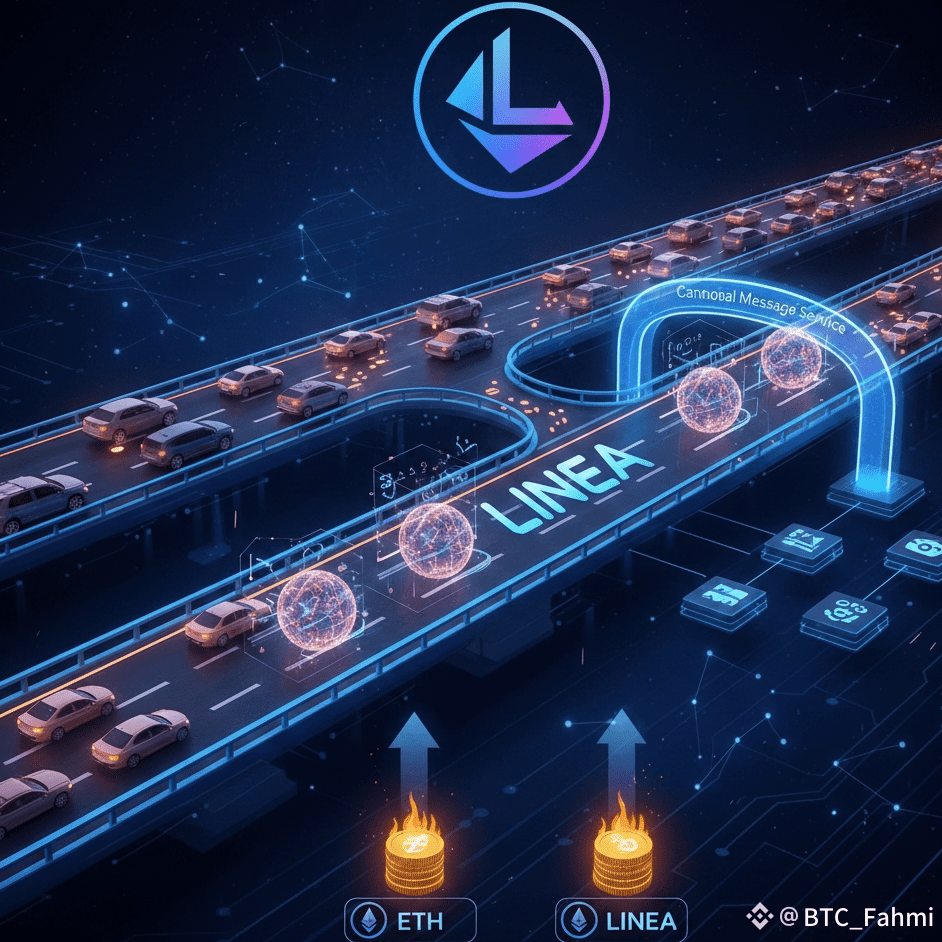
Linea is a quiet attempt to fix a very old Ethereum problem. The network is good. But it’s crowded and expensive to use. People trust Ethereum, developers like building on it. But high gas fees and slow busy blocks make it hard to scale to the whole world. Linea doesn’t try to replace Ethereum. It works like an extra lane on the same highway giving Ethereum more room to breathe. Linea handles lots of transactions off-chain bundles them together proves they are valid with zero-knowledge proofs and then sends only that proof back to Ethereum. This keeps costs low but still uses Ethereum’s security. Because Linea is fully EVM equivalent the same smart contracts and tools that work on Ethereum also work on Linea. Developers can keep using MetaMask Infura Truffle and their existing code without learning something new. To connect Ethereum and Linea the network uses something called the Canonical Message Service. It’s a simple messaging system where watchers look for messages on one chain and relay them to the other. It’s built to become more decentralized over time but for now the focus is on keeping things simple and reliable instead of rushing a complicated bridge that might break. Under the hood, Linea uses efficient zk SNARKs and carefully chosen cryptographic techniques. These are picked for stability security and future resistance to threats like quantum computing not just for hype. Proofs of many transactions are compressed and posted to Ethereum and Ethereum remains the final source of truth. The token design is also different from many other new networks. Linea uses ETH for gas not its own token. That means using Linea still supports Ethereum’s value system. The LINEA token exists, but it’s not used to pay fees. Its supply is set as 1,000 times Ethereum’s original supply to signal that it’s a companion token not a rival. Most LINEA tokens are reserved for long-term ecosystem growth research tools and rewards for builders and users with only a small locked portion going to the treasury. Value moves through a dual burn system. When users pay gas in ETH on Linea. The network covers its costs and then splits the extra ETH. Some ETH is burned shrinking Ethereum’s supply. The rest is used to buy and burn LINEA, reducing its supply too. This ties Linea’s health to real usage not inflation or flashy yield tricks. Bridged ETH can also be staked on Linea, and the yield is shared with liquidity providers and ecosystem users making bridged assets more useful. Linea’s ecosystem has grown quickly. Early programs brought in millions of wallets and DeFi activity has reached billions in total value locked. Aave came early followed by many DEXs, lending protocols liquidity layers NFT platforms games and tools that treat Linea like a natural extension of Ethereum. MetaMask supports Linea natively so users can switch networks with a single click, which removes a lot of friction. The project also has strong backing. It’s built by ConsenSys the team behind MetaMask and Infura which already works with many enterprises. That makes Linea attractive for tokenization settlements and regulated finance experiments that need stability and compliance rather than risky experiments. The idea is to give serious long term players a scaling option that still feels very close to Ethereum. There are real challenges. Linea currently uses a centralized sequencer which the team plans to decentralize over time. Proving zero-knowledge proofs is expensive and needs to scale well or it could slow down confirmations and hurt profits. The dual burn token model also depends on strong, steady usage. If activity falls or costs rise the burn effect weakens and the token relies more on market sentiment. Competition is intense too. Other zkEVM L2s like Polygon zkEVM zkSync Era and Scroll are all fighting for developers and liquidity. Linea’s edge is its tight alignment with Ethereum and ConsenSys but in crypto advantages can fade fast if others move quicker. On top of that ConsenSys’ ties to institutions mean more regulatory pressure and expectations. Which could slow experimentation and decentralization. Even so the path forward is clear. Linea plans to decentralize its sequencer expand its prover network and open up its messaging layer step by step. Its large ecosystem fund gives it time to support grants audits and public goods long after initial hype fades. The dual burn design means real usage strengthens both ETH and LINEA. Over time Linea aims to support real-world apps tokenized assets cheap consumer apps and enterprise workflows that can’t run directly on Ethereum because of cost. In the end Linea isn’t about changing Ethereum. It’s about stretching it. It stays close to Ethereum’s values tools and security while giving the network more space to grow. If Ethereum wins Linea wins. Users and developers can shift to Linea without feeling like they’ve abandoned the main chain. It offers one vision of Ethereum’s future a faster cheaper proof-based layer that keeps Ethereum’s spirit while making room for the next wave of innovation.


